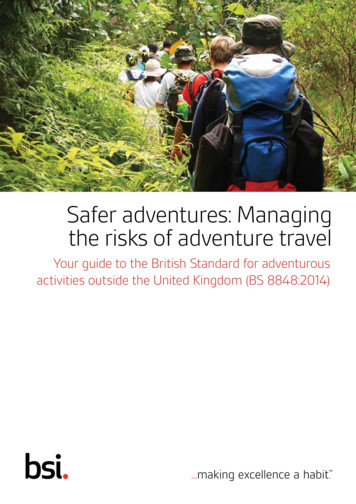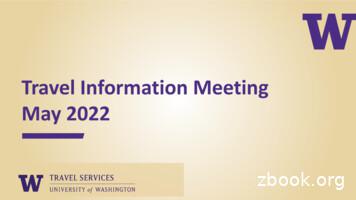ADVENTURE TRAVEL Guide Qualifications & Performance Standard
ADVENTURE TRAVELGuide Qualifications& Performance StandardInternational Adventure TravelGuide Qualifications & Performance StandardSantiago, Chile ATTA / Nicolás Aguayo Fuenzalida1Adventure Travel Trade Association
[Contents]3INTRODUCTION5HOW TO APPLY AND USE THIS STANDARD6ADVENTURE TRAVEL GUIDING CORE COMPETENCIES7TECHNICAL COMPETENCIES9WILDERNESS MEDICINE & FIRST AID10CUSTOMER SERVICE & GROUP MANAGEMENT SKILLS12NATURAL & CULTURAL HISTORY INTERPRETATION14SUSTAINABILITY17RECOMMENDATIONS FOR IMPLEMENTING THIS STANDARD20GOVERNANCE21GOVERNANCE BOARD STRUCTURE23GEOGRAPHIC MEMBERSHIP GOALS25DEFINITIONSInternational Adventure TravelGuide Qualifications & Performance Standard2Adventure Travel Trade Association
Pichincha, Ecuador ATTA[Introduction]The adventure travel industry has grownrapidly over the last few decades, expandingfrom an estimated 89 billion in 2010 to 263billion in 2013, with an estimated four out of teninternational travelers incorporating adventureactivities into their travel plans.1 With such rapidgrowth, increasing numbers of businesses andguests are entering the marketplace, and theindustry needs clear guidance with respectto adventure travel guide qualifications andperformance.Adventure travel guides and tour leaders areat the crux of the adventure travel experience.They provide for the safety of adventuretravelers, ensure the overall quality of theguests’ experience, and ultimately deliverand safeguard an adventure travel company’sreputation. An excellent guide in one destinationcan raise the bar for the industry, while a lesscompetent guide in another can just as easilyset the industry back.Despite the importance of quality adventuretravel guiding, recent research confirms theabsence of a global standard specifically for1 ADVENTURE TRAVEL TRADE ASSOCIATION & GEORGE WASHINGTONUNIVERSITY Adventure Tourism Market Study [Online] August 2013 Available h/adventure-tourism-market-study-2013web.pdf [Accessed 18/12/15]International Adventure TravelGuide Qualifications & Performance Standard3Adventure Travel Trade Association
[INTRODUCTION]adventure travel guides. Although numeroustypes of standards and quality assurancesystems with relevance to adventure tourismexist, none directly address the range ofqualifications necessary for excellent adventuretravel guiding. For example, many people inthe industry may be familiar with standards andquality assurance systems such as these:From this list, only the ISO safety standard foradventure tourism (ISO 21101 and TR 21102)2addresses adventure travel specifically, andnone of these standards or quality assurancesystems cover all the aspects necessary forexcellent adventure travel guiding.In the absence of a global qualification andperformance standard, a variety of approachesto managing adventure travel guiding can befound around the world. While in some countriesthere are no active standards at all, in othercountries one can find detailed governmentregulations specifying training requirements toreceive a national adventure guide certification.Many destinations also have guide associations,which may establish their own training andoperating standards. In addition, over time thecommercial sector has established its owncodes of operating, requiring that guides at aminimum receive specialized certifications fortechnical activities such as rafting, kayaking, andclimbing. However, these certifications are notwell publicized or understood by travelers andnot enforced, except by companies through theirindividual hiring practices.Standard Quality Assurance Systems Technical standards for specific activitiessuch as white water rafting, rock climbingor mountaineeringHospitality and guest service standardsQuality systems to regulate attractionsand venuesQuality guidelines for interpretationprovided by guidesState and national training requirementsfor guidesISO Safety Standards for AdventureTourismIn an effort to support the industry as itcontinues to expand and professionalize,the Adventure Travel Trade Association(ATTA) initiated this Adventure Travel GuideQualification and Performance Standard. Thestandard was developed between the months ofNovember 2014 and December 2015, by a groupof 22 industry professionals organized by theATTA. The working group was open to all andattracted volunteers from 16 countries, includingguides, business owners, and industry partners.The full list of participants can be found here.2 ISO (2014) ISO 21101: Adventure Tourism, Safety Management SystemsRequirements [Online] January 2014. Available from: :v1:en [Accessed: 18/12/15]International Adventure TravelGuide Qualifications & Performance Standard4Adventure Travel Trade Association
Chile ATTA[How to Apply and Use This Standard]This standard is not enforced or regulated inany way by the ATTA or any other organization.Governments, destination managers, andcompany owners may refer to this standardwhen evaluating the quality and performance oftheir own guides and determining appropriatetraining programs. Governments may chooseto create their own regulations based upon thisstandard, but this document is not intended,nor should be used, to supersede local orInternational Adventure TravelGuide Qualifications & Performance Standardnational laws. Both new and experienced guidesmay refer to the standard as a benchmarkfor evaluating their own performance anddetermining the course of their training. Thisstandard has been written to specificallyapply to adventure travel guides. It may proveapplicable to adventure activity providers,or instructors, but has a greater focus on theneeds and requirements of a guide within theadventure travel sector (see definitions).5Adventure Travel Trade Association
[Adventure Travel Guiding Core Competencies]Adventure travel is an extremely diverseindustry. Diverse in terms of geography, withadventure travel businesses located all aroundthe world, and diverse in terms of activities,with a constantly evolving list of new activitiesand products for adventure travel guides tointroduce to guests. This diversity has resultedin a multitude of approaches to measuringadventure travel guide performance as wellas numerous approaches for incorporatingstandards into training schemes. Governmentinvolvement, through laws and regulations, alsoimpacts the enactment of standards.The following pages describe and provideexamples to illustrate each of these corecompetencies.These competencies align with and expand onISO 21101 and TR 21102, which define the role ofan adventure travel guide as follows:The role of the leader, regardless of theadventure tourism activity being undertaken,usually includes:1. Participant assistance;Despite this diversity, universal qualificationshave emerged for adventure travel guides,regardless of the activity or destination.The following five competencies have beendetermined essential for adventure travelguides, regardless of geography or activities:2. Safety management and care ofparticipants and the leadership team inaccordance with the operator’s safetymanagement system, including theprovision of appropriate information,instruction, supervision, and training;3. Application of emergency procedures;1TECHNICAL COMPETENCY2WILDERNESS MEDICINE & FIRST AID3CUSTOMER SERVICE & GROUPMANAGEMENT SKILLS4NATURAL & CULTURAL HISTORYINTERPRETATION (CONTENT DELIVERY)5SUSTAINABILITYInternational Adventure TravelGuide Qualifications & Performance Standard4. Information sharing.6Adventure Travel Trade Association
[ADVENTURE TRAVEL GUIDING CORE COMPETENCIES]1TECHNICAL COMPETENCYWhere standards and protocols currently exist for adventure travel guides, most pertain to sportspecific skills, such as whitewater rafting, rock climbing, or mountaineering, for example. Numerouscertifications and certifying bodies exist, as do training resources for many activities. The technicalcompetency portion of the Adventure Travel Guide Qualification and Performance Standard isdirected to the technical skills and abilities guides must possess regardless of what activity they areleading. ISO 21101 has been referenced for alignment.Guides must possessWhen no certification is required/available,the activity protocol must be determined anddocumented.the technical ability,including current,a. Example: A coast walking providerreferences the existing protocol for hikingor hill walking.available sport-specificcer tifications, tob. The protocol must incorporate relevantexisting standards.safely carr y outi.activities of fered in thecommercial tripExample: Snowshoe hikingincorporates an avalancheprotocol.Some technical skills apply, regardless ofgeography and activity, and must always bepresent:For example, in cases in which an activity isregulated by a local or national governingbody, all rules must be observed.a. Orientation and navigation;b. Managing emergency situations, risks,and hazards.(BC)3a. Example: British Canoeingcertifications would be required throughoutthe UK for canoe and kayak guides.b. Example: The International RaftingFederation (IRF)4 provides certificationsfor whitewater rafting in different crafts.International Adventure TravelGuide Qualifications & Performance Standard3 BRITISH CANOEING [Online] Available from: http://www.bcu.org.uk/testsand-awards/ [Accessed: 18/12/15]4 INTERNATIONAL RAFTING FEDERATION [Online] Available from: / [Accessed: 18/12/15]7Adventure Travel Trade Association
[ADVENTURE TRAVEL GUIDING CORE COMPETENCIES] 1. TECHNICAL COMPETENCYGuides must obser verelevant safetyprotocols specific to thecompany, location, andactivitiesSafety protocols include, but are not limited to:a. Emergency response;b. Required certifications;c. Duty to act (administering care toparticipants);Guides must haved. Guide-to-guest ratio;received currenttraining and licensese. Appropriate operating procedures andrisk assessments.(if applicable) specificGuides must adhere to the protocol orstandard that is more strict or specific to theactivity or location, especially when dictatedby law.to the equipment andvehicles useda. Example: A company may have amaximum group size protocol that isgreater than regulations for the landthey will guide in. The smaller groupsize dictated by the local regulationsupersedes the company protocol.International Adventure TravelGuide Qualifications & Performance StandardCertifications and licenses may be determinedby the local laws, industry standards, orcompany protocol8Adventure Travel Trade Association
[ADVENTURE TRAVEL GUIDING CORE COMPETENCIES]2WILDERNESS MEDICINE AND FIRST AIDThe often remote nature of adventure travel trips, combined with the presence of various degreesof physical activity, means the likelihood is high that an adventure travel guide will need to respondto some form of first aid or medical emergency at various times throughout his/her career.Guides must possess afirst aid cer tificationbased on the recognizedprotocol for the amountof time required toreach definitive careExamples of certification include: StandardFirst Aid, Wilderness First Aid, Wilderness FirstResponder, and Wilderness EMT.The accepted protocol comes from theWilderness Medical Society5 and InternationalLiaison Committee on Resuscitation (ILCOR). 6a. The exact training requirement will varyby region and activity.a. Other standards exist but must align withthese protocols.b. Training should include hands-on CPRand scenario-based training in theoutdoors.i.For Remote care, refer to the WMSprotocols.ii. For “Standard” first aid, refer toILCOR standards for your region.5 WILDERNESS MEDICAL SOCIETY (2015) Wilderness Medical Society [Online] Available from: http://www.wms.org/ [Accessed: 18/12/15]6 INTERNATIONAL LIAISON COMMITTEE ON RESUSCITATION. (2015) [Online}Available from: http://www.ilcor.org/home/ [Accessed: 09/01/16]International Adventure TravelGuide Qualifications & Performance Standard9Adventure Travel Trade Association
[ADVENTURE TRAVEL GUIDING CORE COMPETENCIES]3CUSTOMER SERVICE & GROUP MANAGEMENT SKILLSA greater focus on customer service differentiates adventure travel guides from adventure educatorsand adventure recreation providers. Customer service techniques for an adventure travel guidebalance service with a safety protocol required for adventure activities and/or remote locations.Additionally, a guide is responsible for relationship management with both guests and local people,must be able to communicate in the relevant local language(s) or through interpreters, and must becapable of intercultural communication and interpersonal skills.Guides must be trainedc. The guide must be able to identifycomplaints and handle conflicts, eitherin a solving, mediating, or compromisingway, providing aftercare and creatingopportunities for feedback.with an emphasis oncustomer ser vicea. The guide shows interest in the ideas,views and principles of participants andothers concerned, in a respectful andtolerant manner.d. The guide establishes contacts andmaintains relationships with local partiesas tour guides, drivers, and suppliers.During problems such as disputes orconflicts of interest, the guide acts as anintermediary and works toward achievinga solution that is acceptable for allconcerned.b. During the tour and execution of theitinerary, the guide takes into accountvarying ability levels, physical limitations,and expectations of the group andassesses them in relation to thepossibilities within the itinerary.e. In the case of illness, accidents, or otheremergencies, the guide must be able todeal with the situation and act as trainedfor, according to accepted protocols,safety regulations, and companyinstructions.Specific standards depend on the companyprotocol but must include the following:International Adventure TravelGuide Qualifications & Performance Standard10Adventure Travel Trade Association
[ADVENTURE TRAVEL GUIDING CORE COMPETENCIES] 3. CUSTOMER SERVICE & GROUP MANAGEMENT SKILLSAdditional customer service considerationsexist in adventure travel settings and must beincorporated into guide practices.Guides must possessa. Monitoring the health and well being ofthe guest:i.strong abilities inverbal and non-verbalHydration and food;communicationii. Body temperature and overallcomfort;iii. Mood and spirit.Communication includes the ability to giveclear direction and is an integral component ofconducting a safe activity.b. Managing for varying ability levels.c. Understanding participant expectationsof the experience.Expectations for experience must be clearlycommunicated with guests at the onset.d. Group management/dynamics.a. Questioning techniques must beemployed to ascertain the specificexpectations of guests.b. Guides must strive to exceed guests’expectations, both physical andemotional.Guides must be perceptive to non-verbalcommunication methods in an attempt to readguests’ needs and desires prior to being told.International Adventure TravelGuide Qualifications & Performance Standard11Adventure Travel Trade Association
[ADVENTURE TRAVEL GUIDING CORE COMPETENCIES]4NATURAL & CULTURAL HISTORY INTERPRETATION (CONTENT DELIVERY)An adventure travel guide is expected to be an expert in the subject matter presented on outingsor tours including, but not limited to, natural history, current events, and cultural heritage. Knowingfacts and statistics is not enough; the ability to communicate effectively must also be present.Guides must look to develop both knowledge and skills in communicating to cover a potentiallywide variety of contexts for both the culture and place, as well as the interests of the audience.Content delivery techniques are applied in both formal educational settings as well as in informalcommunications, such as during meals and casual conversation.Guides share content in a manner that is approachable and digestible for guests. This technique iscalled “interpretation” or “thematic interpretation”.Guides must be familiar with the local culture/sof the regions in which they operate.Guides must bea. When incorporating local people, guidesmust do so in authentic and respectfulways.knowledgeable aboutrelevant local histor yb. It is the guide’s responsibility to ensurethat guests are informed of, and follow,respectful practices when interacting withlocal communities.and cultures andpresent accuratec. Appropriate language must be usedwhen interacting with and referring tolocal communities.informationGuides must be knowledgeable and aware ofrelevant local history and current events andbe prepared to present this information in anunbiased manner.International Adventure TravelGuide Qualifications & Performance Standard12Adventure Travel Trade Association
[ADVENTURE TRAVEL GUIDING CORE COMPETENCIES] 4. NATURAL & CULTURAL HISTORY INTERPRETATIONGuides must beEducational techniquesknowledgeable aboutmust be used to sharerelevant natural histor ythis information in anin the environmentsengaging manner withthat they visitguestsa. Basic flora and fauna, ecosystems, andgeneral ecology are important for all guides,at a minimum.a. Delivery must be provocative, engaging, andinspiring.b. Content must be relevant to the audience:b. Guides’ knowledge level must match thespecializations declared by company andguides.i.An effort must be made to learn theinterests, objectives, and knowledge levelof participants and to match the contentto these interests.ii. The guide is responsible for ensuringthat the information presented is beingunderstood by participants.c. Content must be organized in a thematicmanner:i.The guide must have a clear “topic” and“theme” in which the majority of materialpresented fits.ii. The purpose and how it fits into theoverarching story must be clear to theaudience.International Adventure TravelGuide Qualifications & Performance Standard13Adventure Travel Trade Association
[ADVENTURE TRAVEL GUIDING CORE COMPETENCIES]5SUSTAINABILITYA core value of the adventure travel sector is a focus on sustainability, including environmental andsocial sustainability. How guides interact with local partners, and share local cultures and history, iscentral to ensuring the positive impact adventure travel can have in communities. Guides operatesustainably by minimizing environmental impacts and modeling sustainable practices to clients/guests.vii. Be Considerate of Other Visitors(USA, Canada) OR Be Considerateof Your Hosts & Other Visitors(Australia) OR Be Considerate ofOthers (Ireland, New Zealand, UK).Principles of Low ImpactAdventure Travel Guidingb. Training must be geographicallyappropriate to the location in which theguide is leading.Guides must be trained in the principles andapplication of Leave No Trace, appropriate tothe location.c. Emphasis on this application of principalsmust include efforts to stop poaching andtrading of illegal wildlife products.a. As determined by The Leave No TraceCenter for Outdoor Ethics7:i.Additional principals exist, and must beadhered to, as designated “Beyond Leave NoTrace” by Simon and Alagona (2009)8:Plan Ahead and Prepare;ii. Travel and Camp on DurableSurfaces (USA, Canada, Australia)OR Travel and Camp on DurableGround (Ireland, New Zealand, UK);a. Educate yourself and others about theplaces you visit;b. Purchase only the equipment andclothing you need;iii. Dispose of Waste Properly;c. Take care of the equipment and clothingyou have;iv. Leave What You Find;d. Make conscientious food, equipment, andclothing consumption choices;v. Minimize Campfire Impacts;vi. Respect Wildlife (USA, Canada,Australia) OR Respect FarmAnimals & Wildlife (New Zealand,Ireland, UK);7 LEAVE NO TRACE CENTER FOR OUTDOOR ETHICS (2015) Leave No TraceCenter For Outdoor Ethics [Online] Available from: https://lnt.org/ [Accessed:18/12/15]8 SIMON, G. & ALAGONA, P. (2009) Beyond Leave No Trace. Ethics, Place &Environment: A Journal of Philosophy & Geography. 12 (1)
adventure tourism (ISO 21101 and TR 21102)2 addresses adventure travel specifically, and none of these standards or quality assurance systems cover all the aspects necessary for excellent adventure travel guiding. In the absence of a global qualification and performance standard, a variety of approaches to managing adventure travel guiding can be
Adventure tourism is a rapidly expanding sector of the tourism industry internationally. New Zealand is internationally recognised as a country where adventure tourism and adventure sports are undertaken by a large proportion of the resident and visitor population. While the risks associated with adventure tourism and adventure sport activity are increasingly highlighted in media reports of .
the risks of adventure travel. Adventure travel is supposed to be challenging. But regardless of your age, destination or chosen activity, your safety should be of paramount importance. BS 8848 sets standards to minimize the risks of adventure travel. Knowledge of the standard is important to anyone organizing, or taking part in, an overseas venture. 2 Hundreds of thousands of people take part .
1. Corporate Travel Booked through a UW contracted Travel agency listed on the Travel Services Website. 2. Athletics Travel Booked through Athletics travel desk. 3. State of WA Travel Booked through the following as listed on the Travel Services Website. UW contracted Travel agency State contracted Travel agency EasyBiz
KTM 990 Supermoto / R / Adventure 2009 / 16 S-R1 1290 Adventure / S 2015 / 20 R1 1190 Adventure / R 2013 / 16 R1 1090 Adventure / R 2018 / 19 R-1 1050 Adventure 2016 / 17 R1 790 Adventure / R 2019 / 20 S-R1 890 Duke R 2020 S-R1 990 Superduke / R 2009 / 16 S-R1 1290 Superduke 2014 / 16 S-R1 1290 Superduke 2017 / 18 S-R1 1290 Superduke 2019 / 20 S-R1
adventure, “Escape the Tomb.” If you’re playing your first game with friends, play the second adventure, “Find the the dungeon and begin their adventure. It’s twice the size of the Icon of Ravenloft.” Check the “Adventure Setup” section of the Adventure Book to see if your chosen Adventure calls for any of the
ROSS User Guide Travel Plan ‐ creating and editing travel plans 2version 2.16.4 January 13, 2016. Creating a travel plan. This section explains how to create a travel plan and how to add travel plan legs to it. You do not need an incident to create a travel plan. Seeravel "T ‐ setting up resource travel."
a company travel configuration is created for each country the legal entity is located in. Features Available in Travel System Admin To access Travel System Admin, on the menu, click Administration Travel (on the sub-menu) Travel System Admin. NOTE: If Travel System Admin is your only Travel option, then the commands are
ASTM C 1628 06ASTM C 1628 06 Standard Specification for Joints for Concrete Gravity Flow Sewer Pipe Using Rubber Gaskets AS C 16 09ASTM C 1677 09 Standard Specification for Joints for Concrete Box, Using Rubber Gaskets ASTM C 1619 05 Standard Specification for Elastomeric Seals for Joining Concrete Structures ASTM C 505 05a Standard Specification for Irrigation Pipe with Rubber Gasket Joints .























